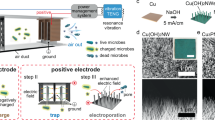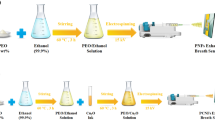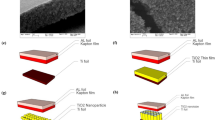Abstract
Negative air ions (NAIs) have been widely harnessed in recent technologies for air pollutant removal and their beneficial effects on human health, including allergy relief and neurotransmitter modulation. Herein, we report a corona-type, mechanically stimulated triboelectric NAI generator. Using the high output voltage from a triboelectric nanogenerator, air molecules can be locally ionized from carbon fibre electrodes through various movements, with the electron–ion transformation efficiency reaching up to 97%. Using a palm-sized device, 1 × 1013 NAIs (theoretically 1 × 105 ions cm−3 in 100 m3 space) are produced in one sliding motion, and particulate matter (PM 2.5) can be rapidly reduced from 999 to 0 µg m−3 in 80 s (in a 5,086 cm3 glass chamber) under an operation frequency of 0.25 Hz. This triboelectric NAI generator is simple, safe and effective, providing an appealing alternative, sustainable avenue to improving health and contributing to a cleaner environment.
This is a preview of subscription content, access via your institution
Access options
Access Nature and 54 other Nature Portfolio journals
Get Nature+, our best-value online-access subscription
$29.99 / 30 days
cancel any time
Subscribe to this journal
Receive 12 digital issues and online access to articles
$119.00 per year
only $9.92 per issue
Buy this article
- Purchase on Springer Link
- Instant access to full article PDF
Prices may be subject to local taxes which are calculated during checkout




Similar content being viewed by others
Data availability
The data that support the plots within this paper and other findings of this study are available from the corresponding authors (V.K.S.H. and Z.L.W.) upon reasonable request.
References
Krueger, A. P. & Reed, E. J. Biological impact of small air ions. Science 193, 1209–1213 (1976).
Jiang, S. Y., Ma, A. & Ramachandran, S. Negative air ions and their effects on human health and air quality improvement. Int. J. Mol. Sci. 19, 2966 (2018).
Ryushi, T. et al. The effect of exposure to negative air ions on the recovery of physiological responses after moderate endurance exercise. Int. J. Biometeorol. 41, 132–136 (1998).
Sawant, V. S., Meena, G. S. & Jadhav, D. B. Effect of negative air ions on fog and smoke. Aerosol Air Qual. Res. 12, 1007–1015 (2012).
Livanova, L. M., Levshina, I. P., Nozdracheva, L. V., Elbakidze, M. G. & Airapetyants, M. G. The protective effects of negative air ions in acute stress in rats with different typological behavioral characteristics. Neurosci. Behav. Physiol. 29, 393–395 (1999).
Wu, C. C. & Lee, G. W. M. Oxidation of volatile organic compounds by negative air ions. Atmos. Environ. 38, 6287–6295 (2004).
Lin, H. F. & Lin, J. M. Generation and determination of negative air ions. J. Anal. Test. 1, 6 (2017).
Richardson, G., Eick, S. A., Harwood, D. J., Rosen, K. G. & Dobbs, F. Negative air ionisation and the production of hydrogen peroxide. Atmos. Environ. 37, 3701–3706 (2003).
Peterson, M. S., Zhang, W., Fisher, T. S. & Garimella, S. V. Low-voltage ionization of air with carbon-based materials. Plasma Sources Sci. Technol. 14, 654–660 (2005).
Chen, C. H., Huang, B. R., Lin, T. S., Chen, I. C. & Hsu, C. L. A new negative ion generator using ZnO nanowire array. J. Electrochem. Soc. 153, G894–G896 (2006).
Nakamura, T. & Kubo, T. Tourmaline group crystals reaction with water. Ferroelectrics 137, 13–31 (1992).
Yeh, J. T. et al. Negative air ion releasing properties of tourmaline/bamboo charcoal compounds containing ethylene propylene diene terpolymer/polypropylene composites. J. Appl. Polym. Sci. 113, 1097–1110 (2009).
Fan, F. R., Tian, Z. Q. & Wang, Z. L. Flexible triboelectric generator! Nano Energy 1, 328–334 (2012).
Wu, C. S., Wang, A. C., Ding, W. B., Guo, H. Y. & Wang, Z. L. Triboelectric nanogenerator: a foundation of the energy for the new era. Adv. Energy Mater. 9, 1802906 (2019).
Guo, H. Y. et al. A highly sensitive, self-powered triboelectric auditory sensor for social robotics and hearing aids. Sci. Robot. 3, eaat2516 (2018).
Liu, W. L. et al. Integrated charge excitation triboelectric nanogenerator. Nat. Commun. 10, 1426 (2019).
Liu, Y. et al. Quantifying contact status and the air-breakdown model of charge-excitation triboelectric nanogenerators to maximize charge density. Nat. Commun. 11, 1599 (2020).
Hinchet, R. et al. Transcutaneous ultrasound energy harvesting using capacitive triboelectric technology. Science 365, 491–494 (2019).
Xu, W. H. et al. A droplet-based electricity generator with high instantaneous power density. Nature 578, 392–396 (2020).
Chen, L. et al. Controlling surface charge generated by contact electrification: strategies and applications. Adv. Mater. 30, 1802405 (2018).
Shi, Q., He, T. & Lee, C. More than energy harvesting – combining triboelectric nanogenerator and flexible electronics technology for enabling novel micro-/nano-systems. Nano Energy 57, 851–871 (2019).
Liu, S., Wang, H., He, T., Dong, S. & Lee, C. Switchable textile-triboelectric nanogenerators (S-TENGs) for continuous profile sensing application without environmental interferences. Nano Energy 69, 104462 (2020).
Leung, S. et al. A self‐powered and flexible organometallic halide perovskite photodetector with very high detectivity. Adv. Mater. 30, 1704611 (2018).
Zi, Y. L. et al. Harvesting low-frequency (<5 Hz) irregular mechanical energy: a possible killer application of triboelectric nanogenerator. ACS Nano 10, 4797–4805 (2016).
Li, A. Y., Zi, Y. L., Guo, H. Y., Wang, Z. L. & Fernandez, F. M. Triboelectric nanogenerators for sensitive nano-coulomb molecular mass spectrometry. Nat. Nanotechnol. 12, 481–487 (2017).
Li, C. J. et al. Self-powered electrospinning system driven by a triboelectric nanogenerator. ACS Nano 11, 10439–10445 (2017).
Zi, Y. L. et al. Field emission of electrons powered by a triboelectric nanogenerator. Adv. Funct. Mater. 28, 1800610 (2018).
Cheng, J. et al. Triboelectric microplasma powered by mechanical stimuli. Nat. Commun. 9, 3733 (2018).
Kim, H. J., Han, B., Woo, C. G. & Kim, Y. J. Ozone emission and electrical characteristics of ionizers with different electrode materials, numbers, and diameters. IEEE Trans. Ind. Appl. 53, 459–465 (2017).
Kim, H. J., Han, B., Kim, Y. J., Oda, T. & Won, H. Submicrometer particle removal indoors by a novel electrostatic precipitator with high clean air delivery rate, low ozone emissions, and carbon fiber ionizer. Indoor Air 23, 369–378 (2013).
Tyndall, A. M., Starr, L. H. & Powell, C. F. The mobility of ions in air. Part IV.—Investigations by two new methods. Proc. R. Soc. Lond. A 121, 172–184 (1928).
Skalny, J. D. et al. Mass spectrometric study of negative ions extracted from point to plane negative corona discharge in ambient air at atmospheric pressure. Int. J. Mass Spectrom. 272, 12–21 (2008).
Wu, C. C., Lee, G. W. M., Yang, S., Yu, K. P. & Lou, C. L. Influence of air humidity and the distance from the source on negative air ion concentration in indoor air. Sci. Total Environ. 370, 245–253 (2006).
Lin, L., Li, Y., Khan, M., Sun, J. S. & Lin, J. M. Real-time characterization of negative air ion-induced decomposition of indoor organic contaminants by mass spectrometry. Chem. Commun. 54, 10687–10690 (2018).
Sabo, M., Okuyama, Y., Kucera, M. & Matejcik, S. Transport and stability of negative ions generated by negative corona discharge in air studied using ion mobility-oaTOF spectrometry. Int. J. Mass Spectrom. 334, 19–26 (2013).
COMSOL Multiphysics v.5.2a (COMSOL, 2016); https://cn.comsol.com/comsol-multiphysics
Zi, Y. L. et al. Standards and figure-of-merits for quantifying the performance of triboelectric nanogenerators. Nat. Commun. 6, 8376 (2015).
Acknowledgements
This research was supported by the National Key R&D Project of the Ministry of Science and Technology (grant no. 2016YFA0202704), the Fundamental Research Funds for the Central Universities (grant nos. 2019CDXZWL001 and 2018CDJDWL0011), the National Natural Science Foundation of China (grant no. 51572040) and the Ministry of Science and Technology (MOST), Taiwan (project nos. MOST-107-2221-E-260-016-MY3 and MOST-108-2918-I-260-004). We also thank the characterization service of the Analytical and Testing Center of Chongqing University.
Author information
Authors and Affiliations
Contributions
Z.L.W. supervised the project. H.G. and V.K.S.H. conceived the project and designed the experimental procedures. H.G., J.C. and L.W. fabricated the devices and performed the electrical performance measurements. Y.L. carried out the mass spectrometry analyses. C.A. helped to build the experimental setup. H.G. arranged the figures and analysed the data. H.G., J.C., L.W., V.K.S.H., J.H., A.C.W. and C.H. wrote the manuscript. All authors contributed to the paper.
Corresponding authors
Ethics declarations
Competing interests
The authors declare no competing interests.
Additional information
Publisher’s note Springer Nature remains neutral with regard to jurisdictional claims in published maps and institutional affiliations.
Supplementary information
Supplementary Information
Supplementary Figs. 1–12.
Supplementary Video 1
Demonstration of the PM 2.5 purification process.
Supplementary Video 2
Demonstration of the heavy smog removal process.
Rights and permissions
About this article
Cite this article
Guo, H., Chen, J., Wang, L. et al. A highly efficient triboelectric negative air ion generator. Nat Sustain 4, 147–153 (2021). https://doi.org/10.1038/s41893-020-00628-9
Received:
Accepted:
Published:
Issue Date:
DOI: https://doi.org/10.1038/s41893-020-00628-9
This article is cited by
-
Recent advances in high-performance triboelectric nanogenerators
Nano Research (2023)
-
High performance wide frequency band triboelectric nanogenerator based on multilayer wave superstructure for harvesting vibration energy
Nano Research (2023)
-
Bio-based vitrimeric elastomers enable completely sustainable triboelectric nanogenerator
Science China Materials (2023)
-
Analysis of radioactivity of negative-ion powder and determination of 232Th
Journal of Radioanalytical and Nuclear Chemistry (2023)
-
Stimulation of ambient energy generated electric field on crop plant growth
Nature Food (2022)



